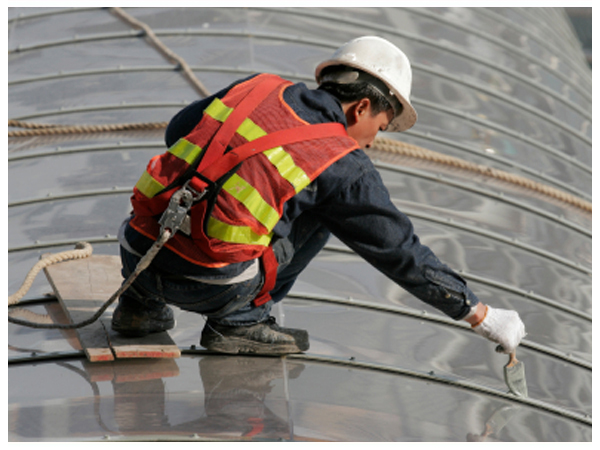Liquid Rubber Fix pond leaks. Waterproofing Fish Pond, Leaks Repair, pond liner, Fountains, & Reflecting Pools with Liquid EPDM Rubber Concrete which has not been modified with special additives must be protected by an impervious coatings when used for containing water. Unprotected concrete will absorb water which can then leach out soluble constituents and cause spalling when frozen. The combination of outdoor exposure plus water immersion creates a demanding environment for a coating. It must have high resistance to water penetration, be flexible enough to withstand extremes in temperature, and not be affected by ultra violet radiation from the sun. Liquid EPDM rubber coatings possess all this characteristics and are also non toxic to fish.
Preparation. Drain water and clean surface dirt while concrete is still wet. High pressure water spray and/or scouring surface with a wire brush may be necessary in fish ponds. If algae is present treat with an algaecide or 25% solution of bleach, let stand for one hour and rise well. Allow one week (rain free) for concrete to dry out.
If you are using this in Koi tanks in immersion conditions, make sure you have 2 coats of Liquid EPDM and that you have a full cure. To do so, let cure in air (without water) for about 1 week in 70 deg F or more ). Soak and rinse out the tank several times with water before making this ready for the Koi. The soaking and rinsing is to ensure you get out any residue solvents after the curing process. You will of course need to prepare the water for the Koy in whatever normal way you prepare Koi tanks/ponds.
Whether your pond is concrete, plastic or rubber lined. EPDM Liquid Rubber can fix your leaks troubles. Plastic pond liners have a tendency to crack or to tear. There are products such at tapes and caulks that will eventually wear. EPDM Liquid Rubber, on the will not. For concrete ponds the easiest solution for leaks are to cover them with a rubber liner but they are tricky to install. Liquid Rubber Coatings provides an easy one-time solution to your pond leak regardless of if they are made of rubber, concrete or plastic. And yes, it is safe for fish!
Liquid Rubber for Coating Plywood:
Liquid Rubber Coatings has been used directly over plywood to make a finished roof in situations where expediency and minimal cost were the primary considerations. Although this procedure results in a weaker roof structure, water-tightness can be achieved if the application is performed carefully. The joint between sheets should be positioned directly over a roof truss and securely fastened to prevent warping. Next, to seal the pores, coat plywood with an oil based primer. Allow an overnight cure. Seal the joint by bridging it with a 6″ wide polyester fabric strip. Apply a light coat of EPDM rubber over the joint, lay fabric into wet rubber and smooth out wrinkles. Complete job by applying a liberal coat of Liquid Rubber over entire roof surface, being especially careful to completely cover the fabric over the joint without skips or pinholes. Using an oil base primer on the wood considerably improves the appearance of a one-coat application of Liquid Rubber.
Liquid Rubber is excellent for Wood Surfaces Repair Product; Liquid Rubber can be applied to wood. We recommend first applying a primer coat using an oil base primer and then the Liquid Rubber after the primer has dried. Liquid Rubber can be colored using “universal” colorants available at any paint store. You can add up to one cup per gallon of paint thinner for easier handling when going over wood. Liquid Rubber is slippery when there is only a fine mist of water on its surface. Silicone and oil-based materials are considered unstable and should be avoided.



